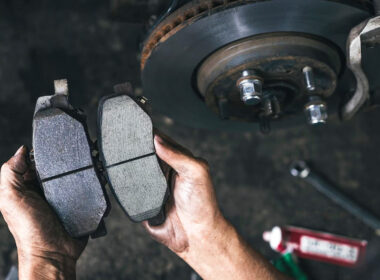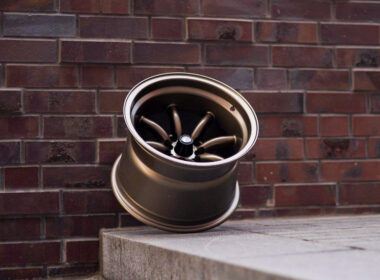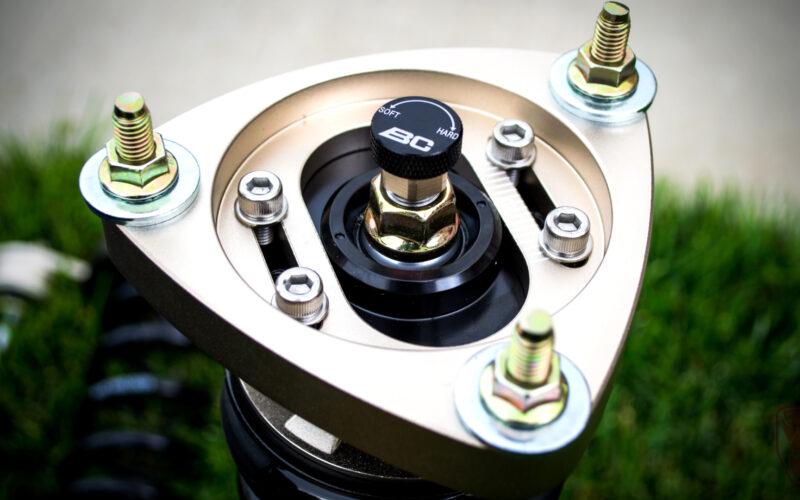There are many good reasons why you might want to adjust your camber angle. Maybe you love tracking your car and want a bit more traction in the corners, or maybe you’re into drifting and want to maximize your contact patch at full steering lock.
Camber plates allow you to do all of that, and then some. However, what camber plates won’t allow you to do is to dial in absurd negative camber angles like -7° to -10° or more.

Stance guys looking for the Onikyan aesthetic are better off with adjustable control arms and possibly body modifications.
Wheel alignment is a tricky subject, but camber plates are extremely simple to install and adjust. All you need is an Allen wrench and a few basic tools to get you started.
Read on to learn more about what camber plates are, how they work, and how you can adjust them.
What Are Camber Plates?

Camber plates are basically CNC-machined, fully adjustable OEM-replacement strut mounts that allow you to position your struts or coilovers in a way that adjusts your camber and caster angle. You can also use these even if you have a strut bar installed.
The best part about installing these plates is that you can change your camber angle very easily, whenever you want, with just an Allen wrench.
They come in a ton of different varieties to fit different suspension systems, but they all work the same way. In most cases, you can combine them with stock struts, but you’re better off using them with coilovers.

For example, if your OEM strut spring perch is too large, it’s going to limit your adjustability by coming into contact with the strut tower bolt. Coilovers typically have smaller spring perches, which go well with camber plates.
Camber plates aren’t the only part that allows for camber and caster adjustability. Most OEM suspension setups offer some amount of adjustability with the help of parts such as turn-buckle joints, shims, eccentric bolts, or even adjustable control arms.
Unlike camber bolts that max out at 1.5°, camber plates allow for 2° to 3° of adjustment. Anything more than that will require aftermarket control arms.
How Do Camber Plates Work?
No matter what kind of camber plate you go with they work in a similar way. The top portion of the plate bolts directly onto the existing strut mount, and the bottom portion attaches to the strut, connecting the two as a result.
When making adjustments, the top part of the plate stays flush with the strut tower mount, but the bottom part remains movable so you can get the required camber adjustment. It’s a relatively straightforward but highly effective system for adjusting your car’s camber.
How to Adjust Camber Plates?

While there are different styles of camber plates out there, the adjustment procedures are pretty similar and straightforward for most of them.
They work with an Allen wrench, which you can use to loosen up the four adjustment screws on top of the camber plate. After breaking the screws loose, you can move the strut/coilover in or out.
Be sure to line it up with one of the markers on the top of the camber plate. With most camber plates and coilovers, each marking equals a change of 1/2°.
Once you have the camber plate in the desired position, tighten down and torque the four screws to hold everything in place. Repeat the process on the other side of your vehicle to match the one you just adjusted.
When adjusting the camber of your vehicle, try making small adjustments at a time and don’t change up a bunch of other components at the same time.
Furthermore, if you need to make adjustments, making small changes with just one component will give you a better idea of how to remedy the situation.
Installation

Now that you know about the benefits of camber plates and how easy it is to adjust them, let’s take a look at how to install them on your car in the first place.
If you don’t have any wrenching experience whatsoever, we highly recommend taking your car to a mechanic for camber plate installation.
The exact procedure will vary a bit depending on the camber plates you go with and the vehicle you drive.
Read the instructions that come with your camber plates since they should walk you through everything you need to know but pay special attention to any warnings that they highlight.
If you need to undo your spring by separating it from the strut, don’t forget to use a spring compressor for safety. Loaded springs are extremely dangerous and care should be taken when handling them.
This is one of the reasons why we recommend having a professional install your camber plates if you don’t have any automotive experience.
Coilovers With Camber Plates

If you’re installing coilovers on your car, you might think it’s the perfect time to install camber plates as well. While in some cases it’s a great opportunity, other times it’s completely unnecessary.
That’s because of two reasons:
- Most cars have some form of OEM camber adjustability which should be taken advantage of while installing coilovers. The adjustments are not that easy to make after you have the coilovers on. This only applies if you want under 1.5° of adjustment.
- Many coilovers come with a camber plate already installed. However, sometimes you might need an additional component like a top hat to make it work.
Either way, do your homework for the kit you’re interested in and your vehicle to figure out exactly what you need before you start ordering a ton of parts you might not need.
Final Adjustments

Now that you know a little more about the perks of camber plates and how easy they are to use, it’s time for you to get your own camber plates on order.
They’re a great way to quickly and easily adjust the camber on your vehicle and compared to many other components they’re not that expensive! Just ensure that you install them correctly to avoid potential problems down the road.
If you’re thinking about buying some camber plates to give your car a wider range of adjustment angles, check out our range of products today.




